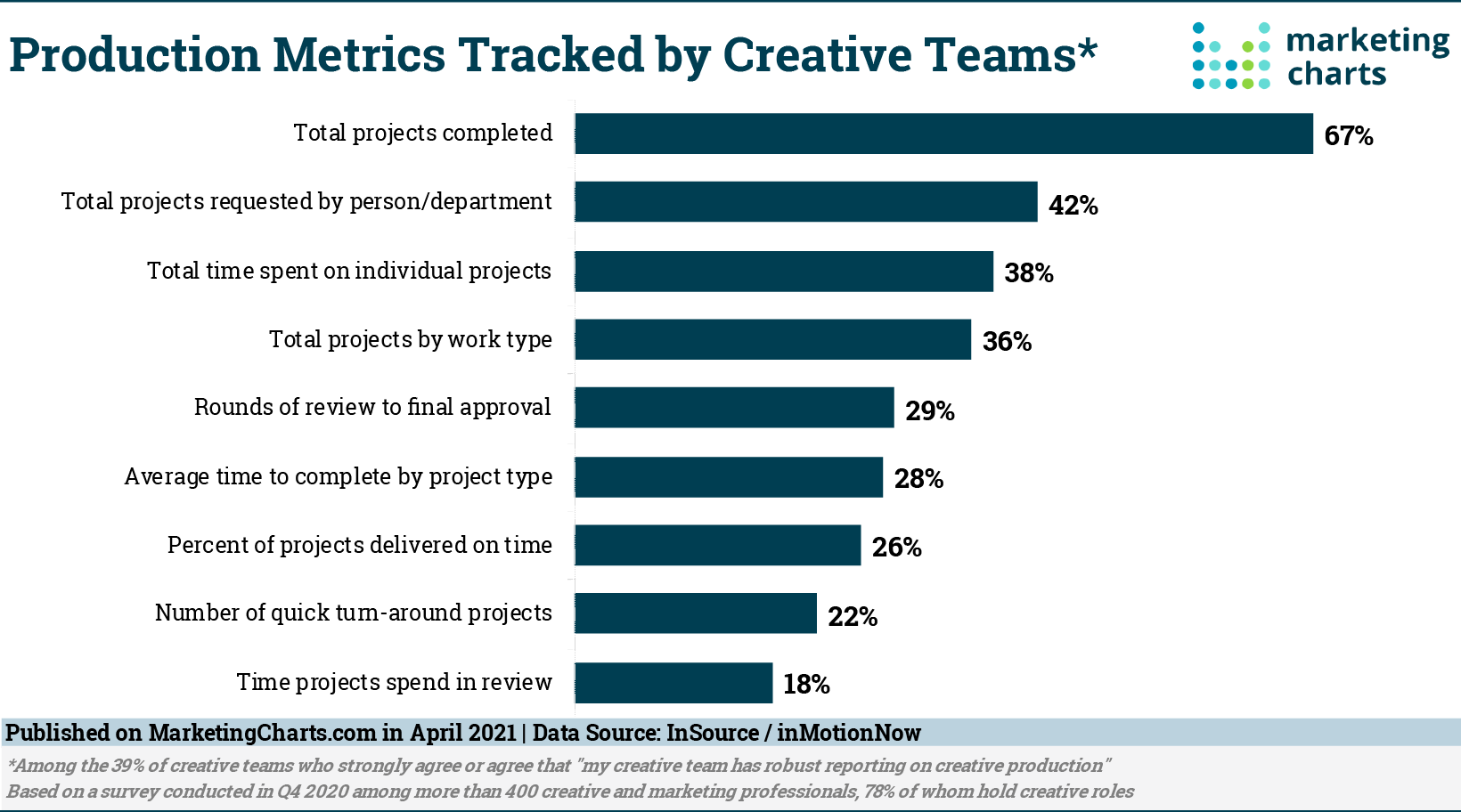What Metrics Are Creative Teams Tracking?

See you on the action-field,
Raksha Sukhia, SMB Growth Expert,
Founder BBR Network. #bbrnetwork

Data drives many aspects of marketing, whether it’s used to improve lead generation quality, to deliver better customer experience or to prove ROI on marketing efforts. Creative teams are not immune from the need to report on their operations, however, a report [download page] from InMotionNow and InSource shows that only about 2 in 5 creative teams have robust operations reporting.
There has been very modest improvement on the reporting front for creative teams over the past two years. In 2019, only 36% reported having robust operations reporting, compared to the 39% who did so in both 2020 and 2021.
Of the 39% who have robust reporting, the most prevalent metric tracked is total projects completed (67%). While not as widespread, metrics such as total projects requested by person/department (42%), total time spent on individual projects (38%) and total projects by work type (36%) are also being tracked. And, to an even lesser extent, these teams are also reporting on average time to complete by project type (28%), percent of projects delivered on time (26%) and the time projects spend in review (18%).
When asked why they track and report on these metrics, the reasons include being able to manage team capacity and resources (57%), plan for the future (51%) and continually improve progress (51%). Only a comparatively small percentage say they track and report on these metrics in order to measure ROI of content (22%) or improve content outcomes (20%).
Additionally, more than two-fifths (44%) track and report on these metrics so they can promote the value of the team to organizational leaders. Indeed, 6 in 10 say they present reports on key metrics to organizational leadership, either presenting them directly to senior leadership (27%), directly to middle-level management (21%) or as part of the marketing team to senior leadership (14%).
Challenges of the Pandemic and Beyond
Creatives do feel that their work is valuable. Some 93% believe that creative content is considered important to the success of their organization’s key objectives, while 9 in 10 also say they are getting the same or more credit for driving content outcomes than they did last year — about the same share who said the same last year.
Of course, the pandemic did present some unexpected challenges. Creatives were forced to pivot on the priority of their projects (72%), the type of content they produced (65%) and the tone of the content they produced (60%), while, at the same time, dealing with teams not being able to make planned hires (38%), layoffs or furloughs (31%) and budget cuts that reduced their tech stack (31%).
But, along the way, they became more productive (57%) and to a lesser extent invested time in cross-training and refined their reporting (26%). However, they also report current challenges including the speed at which they are expected to work (73%) and having enough creative resources (61%).
Using Outside Resources
Another way one-third (32%) of creative teams responded to the challenges faced in 2020 was by partnering with external resources. Although the majority (76%) of respondents say they handle at least 75% of their work in-house, close to 9 in 10 (86%) report having brought in outside resources in the form of agencies and freelancers.
This year, 3 in 10 (29%) creative teams think their relationship with external partners will increase. For some, these partners will assist with strategy. Research from Ascend2 found that companies were turning to agencies for help with marketing strategy more so than creative. And, this more recent study found that about one-quarter (24%) of creative teams bring in partners to help develop strategy.
SignUp for Weekly Ezine
Related Article
Related Article
Digital skills, streaming, revenue growth: 5 interesting stats to start your week
What’s a Good Landing Page Conversion Rate?
Business Agility Is the New Norm. Do You Have What It Takes?
Tags
#BBR Network, #LinkedIn #Social Media Marketing, #Profitability, #Small Business Growth, #Small Business Marketing and Sales, #SMB, #SME, B2B, Build Business Results, Build Business Results (BBR), Build Business Results (BBR) Mastermind.










